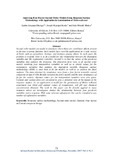Analysing Four Factor Second Order Models Using Response Surface Methodology with Application in Germination of Melia volkensii

View/
Date
2017-12Author
Ayubu, Anapapa O.
Koske, J. K.
Mutiso, J. M.
Metadata
Show full item recordAbstract
Second order models are useful in situations where there are curvilinear effects present in the true response function. Such models have real life applications in a wide variety of fields such as agriculture, biology, and business among others. In such cases the problem is twofold. First is to fit a model for the relationship between the dependent variable and the explanatory variables. Second is to find the values of the predictor variables that optimize the response. The objectives here were to fit second order models involving four independent variables as well as to obtain values for the explanatory variables that optimize the dependent variable. Response surface methodology (RSM) is used both to fit the models as well as to analyze the fitted surfaces. The data obtained by simulation were from a four factor rotatable central composite design (CCD). Results included the fitted models and the tests of adequacy of fit for the models. Optimal values for the independent variables were also given. Contour and surface plots are presented to give a pictorial view of the nature of the response surface. As an application a model for the germination of Melia volkensii experiment was fitted and optimal values of temperature, soil pH and chemical concentration obtained. The work in this paper can be directly applied in many instances where an investigator studies the relationship between four predictor variables and a response. With some relevant adjustments this can be extended to any number of explanatory variables.
URI
http://ir.mu.ac.ke:8080/xmlui/handle/123456789/2839https://www.ajest.info/index.php/ajest/article/view/7
http://hdl.handle.net/123456789/4611
Collections
- Journal Articles (PAS) [303]
